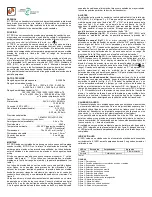
5
Python 3G
User Guide
Safety and Fiber Optic Systems
Optical Fiber Safety
Never look directly into the end of the optic fiber while either end of the system is
operating.
This Python 3G contains CDRH Class 1 laser devices. To prevent damaging your eyes, always
avoid looking directly at, or staring into, the laser light located on an optical connector or
on the end of a fiber.
Infrared radiation is produced at the fiber connection port on the rear of the TX units and at
the end of any un-terminated optical fibers that are attached to this port. Avoid any direct
exposure to the light that comes from these sources.
Do not power up the unit if there are no fiber cables connected to the fiber port.
There are no manual adjustments to make inside the Python 3G. Do not attempt any type
of service on this instrument, other than any procedures as instructed in this Guide. Refer all
servicing to the Fiber Solutions division of Grass Valley
(see
Contact Us
on page 49
).
Always use cable connector caps when the cables are not connected. This protects the
connector from damage and the unlikely event of exposure to an operating optical link.
Keeping the caps in place when the connectors are not in use will prevent dirt and dust
from entering the connector and degrading the performance of the optical link.
FCC Part A Manual Notice
This
equipment
has
been
tested
and
found
to
comply
with
the
limits
for
a
Class
A
digital
device,
pursuant
to
part
15
of
the
FCC
rules.
These
limits
are
designed
to
provide
reasonable
protection
against
harmful
interference
when
the
equipment
is
operated
in
a
commercial
environment.
This
equipment
generates,
uses,
and
can
radiate
radio
frequency
(RF)
energy.
If
not
installed
and
used
in
accordance
with
this
User
Guide,
this
equipment
may
cause
harmful
interference
to
radio
communications.










































